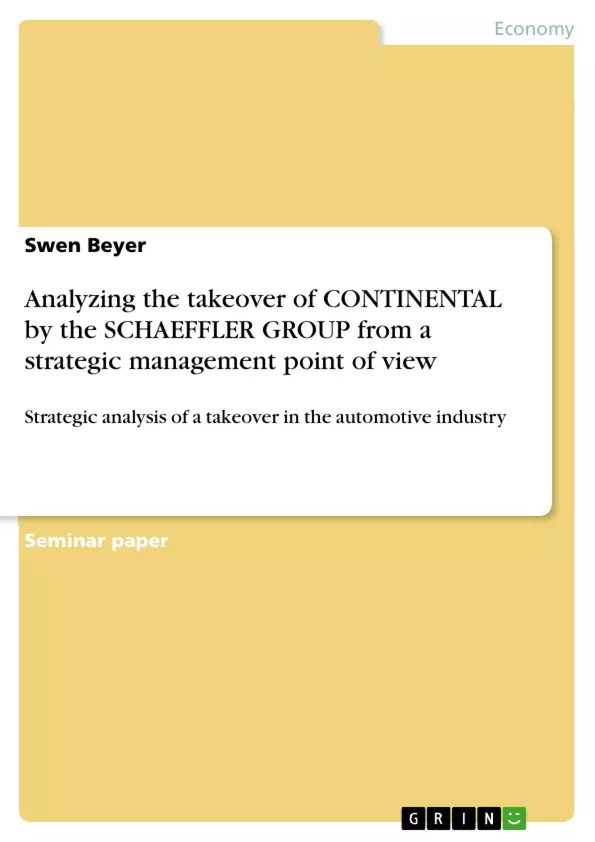On August 21, 2008 Continental accepted Schaeffler´s offer to become a majority shareholder of their company. Both companies signed an investment agreement, including the criteria that Schaeffler is not allowed to hold more than 49.9% of the total shares until 2012. Because of the lucrative offer to the former shareholders of Continental, they have tendered a total of 82.41% to Schaeffler that led to a total holding of approximately 90%. Therefore Schaeffler had to hand over 40% of those shares to banks. Since then, both companies are fighting the credit crunch, rising raw material prices and the financial/ automotive crisis with sharply decreased sales volumes. Currently both suppliers are working together on the first major strategic project, in order to make use of synergies including costs, knowledge and distribution. If Schaeffler will keep all of Continentals “exotic” business units like “tires” it will become an interesting strategic issue as soon as the management can make those fundamental decisions.
Inhaltsverzeichnis (Table of Contents)
- ABSTRACT
- INTRODUCTION
- LITERATUR REVIEW
- BACKGROUND
- INDUSTRY INSIGHTS
- CONTINENTAL CORPORATION - COMAPANY AND PRODUCT OVERVIEW
- SCHAEFFLER GROUP - COMPANY AND PRODUCT OVERVIEW
- THE HOSTILE TAKEOVER OF CONTINENTAL BY SCHAEFFLER
- HOSTILE TAKEOVER
- CHRONOLOGY OF THE TAKEOVER
- PARTICULARITIES OF THE MINORITY SHARE TAKEOVER
- STRATEGIC IMPLICATIONS OF THE TAKEOVER
- CHALLENGES FOR COMPANIES IN MATURING INDUSTRIES
- SCHAEFFLER'S STRATEGIC GROWTH DECISION ON A CORPORATE LEVEL
- HORIZONTAL AND VERTICAL INTEGRATION OF BUSINESS UNITS
- IMPACTS OF DIVERSIFICATION ON THE ORGANIZATION
- POTENTIAL BUSINESS DEVELOPMENTS
- CONCLUSION
Zielsetzung und Themenschwerpunkte (Objectives and Key Themes)
This paper analyzes the takeover of the majority share of CONTINENTAL by the SCHAEFFLER GROUP from a strategic management point of view. It aims to explore the strategic implications of this hostile takeover, particularly within the context of the challenging environment faced by the automotive supplier industry.
- The strategic challenges faced by companies operating in mature industries, particularly in the automotive sector.
- The strategic growth decision of the SCHAEFFLER GROUP and its implications for the company.
- The impact of horizontal and vertical integration of business units on the overall strategy of the combined companies.
- The potential business developments that may emerge as a result of the takeover.
- The challenges of managing a hostile takeover and the impact of the global financial and automotive crisis on the process.
Zusammenfassung der Kapitel (Chapter Summaries)
The paper begins with an overview of the industry context, highlighting the challenges faced by automotive suppliers due to the global financial crisis and the maturity of the industry. It provides company profiles of both CONTINENTAL and the SCHAEFFLER GROUP, outlining their key products and market positions. The chapter then dives into the hostile takeover process, detailing the timeline of events and the unique aspects of the minority share takeover.
The following chapters analyze the strategic implications of the takeover. This includes exploring the challenges faced by companies in mature industries, examining the strategic growth decision of the SCHAEFFLER GROUP, and analyzing the impact of horizontal and vertical integration of business units. The potential business developments resulting from the takeover are also discussed.
Schlüsselwörter (Keywords)
The paper focuses on the strategic management aspects of the takeover, particularly the impact of the acquisition on the company's growth, integration, and overall business strategy. Key themes include hostile takeovers, strategic growth decisions, horizontal and vertical integration, mature industries, the automotive industry, and the global financial crisis. The paper draws upon academic literature in strategic management and industry analysis.
- Arbeit zitieren
- Swen Beyer (Autor:in), 2010, Analyzing the takeover of CONTINENTAL by the SCHAEFFLER GROUP from a strategic management point of view, München, GRIN Verlag, https://www.grin.com/document/152749



